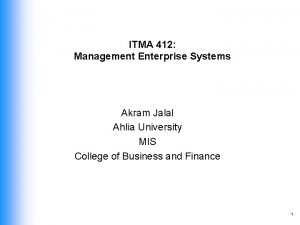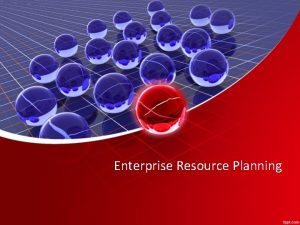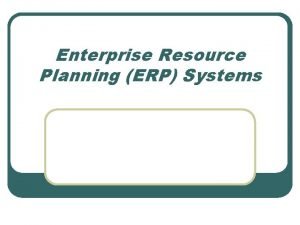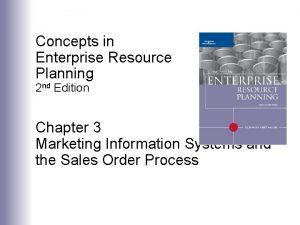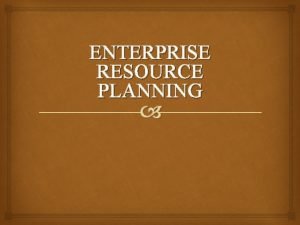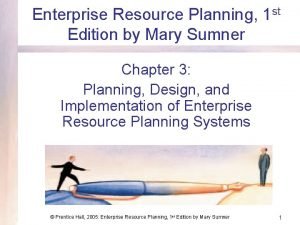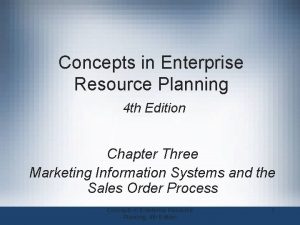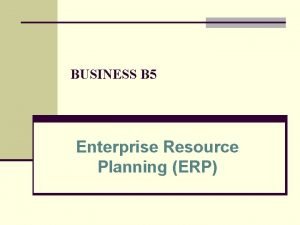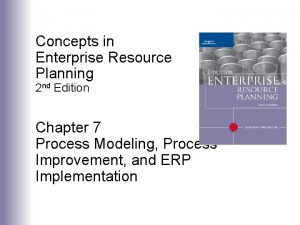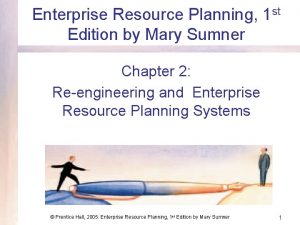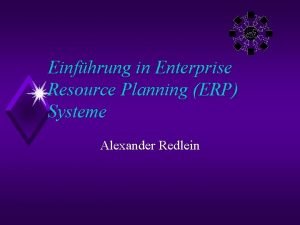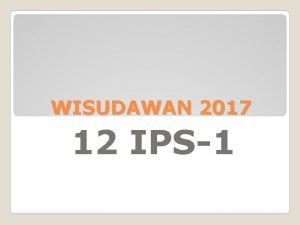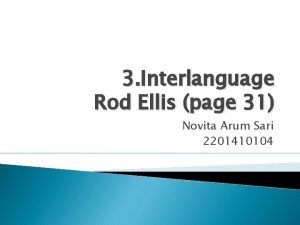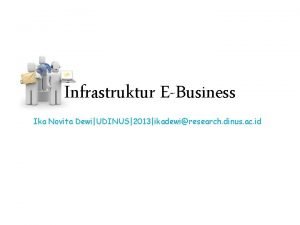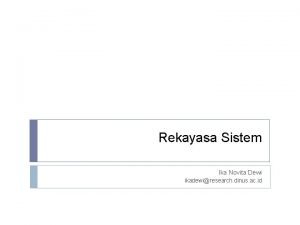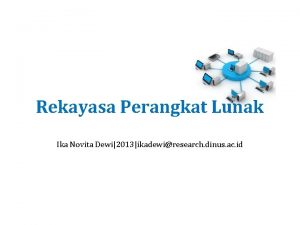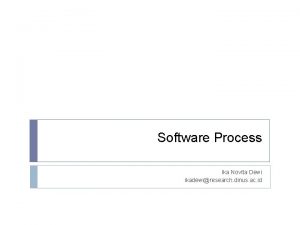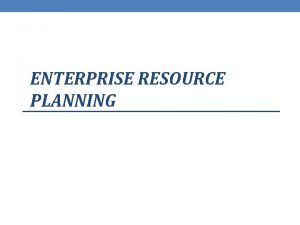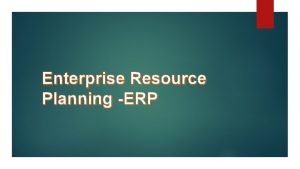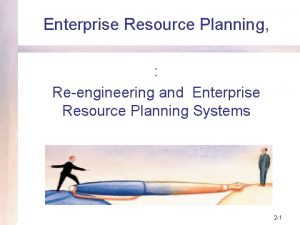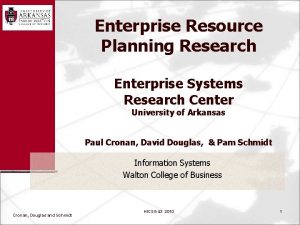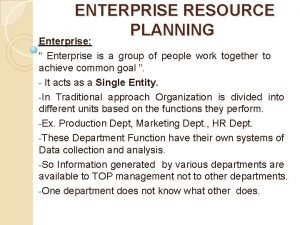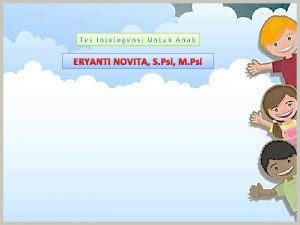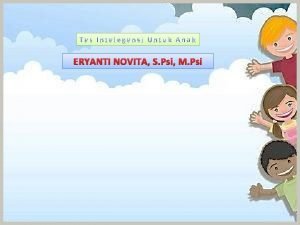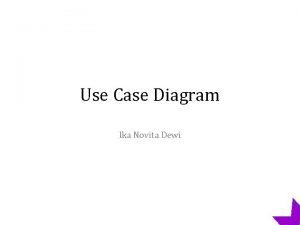Enterprise Resource Planning Ika Novita Dewi2013UDINUSikadewidinus research dinus















![Calculate ROI using this simple equation: • ROI = [(Payback - Investment)/Investment)]*100 • When Calculate ROI using this simple equation: • ROI = [(Payback - Investment)/Investment)]*100 • When](https://slidetodoc.com/presentation_image_h2/72ef6b00047a5b9be4d71c1d4302f905/image-16.jpg)
- Slides: 16

Enterprise Resource Planning Ika Novita Dewi|2013|UDINUS|ikadewi@dinus. research. dinus. ac. id

Enterprise resource planning systems or enterprise systems are software systems for business management, encompassing modules supporting functional areas such as planning, manufacturing, sales, marketing, distribution, accounting, financial, human resource management, project management, inventory management, service and maintenance, transportation and e-business

ERP system concept

ERP evolution

Advantages

Disadvntages

Enterprise systems employ thin client/server (C/S) technology or client/fat server (C/FS) architecture, creating a decentralized computing environment In a C/S system a number of client devices operated by end users such as desktop PCs request services from application servers, which in turn get the requested service-related information from the database servers The requests may be simple data files, data values, communication services, transaction processing or master file updates

The client/server system functions are performed following three layers of logic: Presentation Layer: Graphical user interface (GUI) or browser for data entry or accessing system functions Application Layer: Business rules, functions, logic, and programs acting on data received/transferred from/to the database servers Database Layer: Management of the organization’s operational or transactional data including metadata; mostly employs industry standard RDBMS with structured query language (SQL) provisions

3 -tier ERP system architecture This logical arrangement helps the ERP user interface to run on the clients, the processing modules to run on the middle-tier application servers, and the database system to run on the database servers

Building the Business Case for ERP Describe the business challenge Assess the potential benefits of the ERP investment Assess the potential costs of each ERP option Assess risks and issues that might arise during the implementation Recommend the preferred solution Describe the implementation approach Measure potential and actual ROI

Common challenges that cause companies to consider ERP solutions include: • • A desire to grow the business Inefficient Business Processes A Need to Reduce Costs Obsolete Systems

The types of benefits organizations can expect to achieve by implementing an ERP: • • • Grow the Business Improve Efficiency Integration Provides Coherent Business Information Automation Eliminates Manual Processes Business Intelligence Improves Decisions and Efficiency Better Collaboration

Typical costs for an ERP implementation include: • • Acquisition Cost of Expanding the Solution Training Implementation Customization Administration/Maintenance Future Requirements

Potential risks and issues to consider include: • Operational Risks • IT Risks • Financial Risks

When looking to a vendor’s professional services arm or systems integration partner to help with the implementation, consider factors that include: • Skills and knowledge delivering solutions for your line of business and industry • The longevity of the business providing the service • Use of an implementation methodology that standardizes software implementations by • providing a critical path for all the steps that must occur • How well they document the implementation process, milestones, and deliverables
![Calculate ROI using this simple equation ROI Payback InvestmentInvestment100 When Calculate ROI using this simple equation: • ROI = [(Payback - Investment)/Investment)]*100 • When](https://slidetodoc.com/presentation_image_h2/72ef6b00047a5b9be4d71c1d4302f905/image-16.jpg)
Calculate ROI using this simple equation: • ROI = [(Payback - Investment)/Investment)]*100 • When determining payback, be sure to consider all business processes that are impacted by the new ERP system • Look at all time savings, cost savings, and increased revenues that can be attributed to the new system • Similarly, when calculating investment, consider all costs detailed, including acquisition, training, implementation, maintenance and so on
 Dinus inside
Dinus inside Enterprise resource planning example
Enterprise resource planning example Erp meaning
Erp meaning Enterprise resourse planning systems
Enterprise resourse planning systems Enterprise resourse planning
Enterprise resourse planning Cayenta work management system
Cayenta work management system Sistema erp adalah
Sistema erp adalah Erp adalah
Erp adalah Enterprise resource planning mary sumner
Enterprise resource planning mary sumner Concepts in enterprise resource planning
Concepts in enterprise resource planning Core and extended erp components
Core and extended erp components Contemporary management practices
Contemporary management practices Fitter snacker
Fitter snacker Enterprise resource planning mary sumner
Enterprise resource planning mary sumner Sap lieferplan kopierer sd
Sap lieferplan kopierer sd Dhia novita adristi
Dhia novita adristi Novita arum
Novita arum

